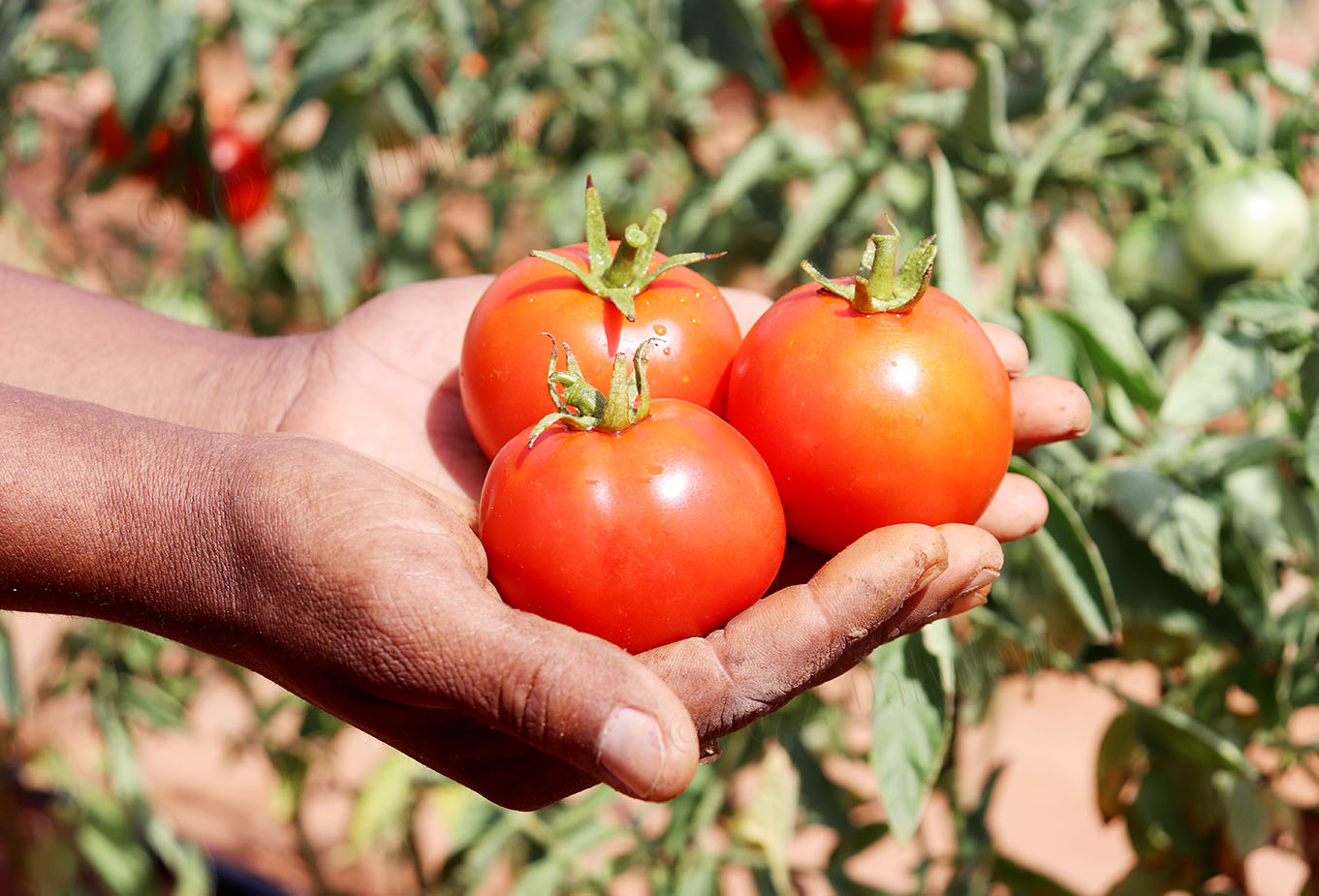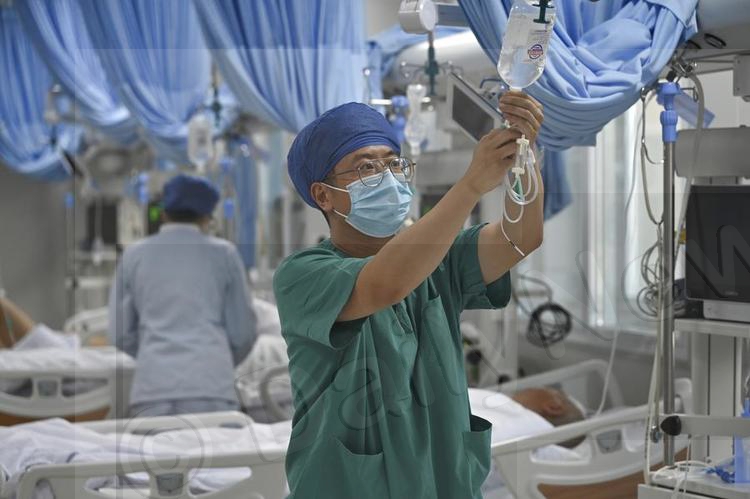Vegetables in the desert How a four-country initiative may change the desert into farmland
20 Mar 2022
If Botswana’s Kgalagadi District were a hoof, its southern-most tip would be the toe. And right on that toe, on the fringe of the mighty Kgalagadi Transfrontier Park, sits the small village of Struizendam.
Driving 50 kilometres northwestward from Bokspits, as the sparrow flies, you come to this small, serene village of about 800 people.
Like most villages and settlements in this corner of the country, its population is predominantly colored.
The scenic countryside has a calming effect on the traveller.
The “Baa! Baa, meh!” of curious nude speckled sheep queries our entry as we drive past a hand dug well, where the flock has been drinking.
A white name board with the inscription ‘STRUIZENDAM’ stands conspicuous against a thicket of the invasive Prosopis, locally known as Sexanana.
The inscription is both informational and a salutation. Cattle and small stock farming small are the bedrock of the villages economy.
We are here to see for ourselves an altogether new phenomenon that desert dwellers in this region are discussing with a mixture of wonderment and disbelief.
A striking beauty Ms Reginah Matthys, welcomes us.
Even at this early hour, when many are just rising, she has long been up, she says. But that should be expected, for nearly everyone in this village is a farmer, and as farmers are wont to do, she was up with the fawn coloured desert lark. Like the tiny bird, she knows that the earlier one picks the fattest worm.
Ms Matthys leads a team of eight young aspiring horticultural farmers. They have purposed to change the narrative that horticulture is not a viable in Kgalagadi.
And they are as determined as a honey badger.
The seemingly hopeless, and extremely hot desert soil can and will yield fresh vegetables, she says, her resolve lining every syllable.
The 41-year old says her village area is among 69 settlements identified by government for ‘targeted focus’ through implementation of Remote Area Development Programme (RADP) Affirmative Action Framework, which started in 2013.
This, she says is deliberate effort by Government to mainstream RADP in all sectors where each sector must have in place initiatives whereby it reaches out to people in remote areas, with a view to creating sustainable livelihoods.
Besides the hot arid soils of her village, people here would not contemplate venturing into horticulture because, whenever the ground yields any water, it is as salty as the sea.
Not only does this discourage vegetable production, she says.
It also limits the number of animals one can keep. This has made life rather difficult for her naturally hardworking community.
Now, Matthys and her team are revolting against the climatic conditions of her region.
Back in November 2021, she got much needed motivation when eight of them were selected by SADC’s Orange-Senqu River Commission (ORASECOM)* to participate in the commission’s horticulture livelihood projects in the Rappelspan and Struizendam areas. The eight were not beneficiaries in any government project.
She says: “Since primary school we were told that the soil in our area is not good for growing vegetables. We grew up knowing that we will never be able to produce our own food. We never had gardens at school. But now I can see that it is very possible to grow our own food and eat from our own gardens,” she says as she walks us to the garden, her otherwise very good English tempered only by a deep Afrikaans accent, common in these parts.
The garden is a beehive of activity. The other members of her team, comprising four men and three women, are busy pruning and trellising tomato trees whose thick, meaty, ripe tomatoes peer at us from firm stalks, openly seducing the eye.
“As you can se the tomatoes, we’re happy that we are able to produce something.
It’s a completely new concept for us, for we grew up knowing that we get our vegetables from the shops,” says Matthys, a smile lighting up her beautiful smooth face.
The garden structure comprises a 50X50m titanium grey, 40 per cent shade and drip irrigation system. Matthys and her team are fired up. Their sponsor recently took them on a tour of horticultural projects in Shakawe and Maun against which they are now benchmarking. During the trip, they bought garlic, which we find one of the team already planting.
I never imagined I could bury a seed and it would grow. After seeing a Motswana grow cucumbers in Shakawe, I realised that was also possible to do it in Kgalagadi,” she says, as she gently ties a string, then winds it around the branches of a tomato tree before tying it up on the lattice.
For now they sell their vegetables to the BORAVAST cluster, which comprises Bokspits, Rappelspan, Vaal Hook and Struizendam villages.
By so doing they save customers the trouble of travelling the 330km or so to the District capital of Tsabong, where they would normally get their produce.
“We are currently selling to individuals, but as we grow we will be looking at other markets such as schools. We are also looking to sell to lodges in the Kgalagadi Transfrontier Park,” she says.
From there, they will be heading to Tsabong. Matthys and her crew are shrewd in their approach.
She explains that at the moment their focus is to grow the business, so they are ploughing their profits back into it.
Only 10 percent of their income goes towards rental of the Village Development Committee plot on which their garden sits.
Enter Mr Force Ramasuswana, Department of Water and Sanitation Services Kgalagadi regional manager.
His department is the chief architect of the horticulture project, which itself is borne of construction of desalination plants in Rappelspan and Struizendam.
The plants are part of ORASECOM’s trans-boundary strategy to address threats to the sustainable development and management of water resources in the Orange Senqu-River Basin.
Under the strategy Botswana received P25million to build the desalination plants, which it did beginning 2020. Out of this amount about P450 000 was set aside for livestock and horticulture development.
The money came from the United Nations Development Programme’s Global Environmental Fund.
Says Mr Ramasuswane: “Under guidance of ORASECOM, towards the end of November 2021, we bought and erected new shade nets; engaged a horticulture expert to mentor the eight beneficiaries for three days, during which he took them through all production steps.”
He has no doubt that the project will grow to create job for other people besides the eight.
Struizendam Kgosi, Isaac Titus is greatly impressed by ORASECOM’s desalination plants’ initiative through which two government boreholes have been rescuscitated and installed with solar powered desalination equipment. From here, water is reticulated to the communities of Struizendam and Rappelspan.
He says: “When water is available, life for the community will definitely improve. This area is good for farming but the problem has been water shortage. Now the villagers will have the opportunity to water their livestock and grow vegetables.”
This will surely reduce unemployment among his people, as already Matthys’ and her colleagues’ project has proven.
Not only that, this project is proof that the desert can – and will hopefully – one day change into farmland. Ends
Source : BOPA
Author : Calviniah Kgautlhe
Location : STRUIZENDAM
Event : Feature
Date : 20 Mar 2022







